Time-Driven Activity-Based Costing Report for Business Management
VerifiedAdded on 2020/05/28
|13
|2504
|129
Report
AI Summary
This report examines Time-Driven Activity-Based Costing (TDABC) and its application within private organizations, using BHP Billiton as a case study. The report begins by defining TDABC and its advantages over traditional costing methods like Activity-Based Costing (ABC), highlighting its simplicity and ease of implementation. It then details the features of TDABC, including capacity cost and time estimation, and differentiates it from other costing models. The report analyzes how TDABC can address cost management challenges faced by companies like BHP Billiton, such as reducing operational costs and improving resource allocation. The report concludes by emphasizing TDABC's effectiveness in providing accurate cost information, streamlining operations, and enhancing decision-making in complex business environments. The structure of this report includes the discussion on suitability of TDABC on private organization operated in Australia. This report is referred to the client named BHP Billiton Plc. and it includes the brief information about the client, introduction of TDABC and its features, reliability of TDABC for client.
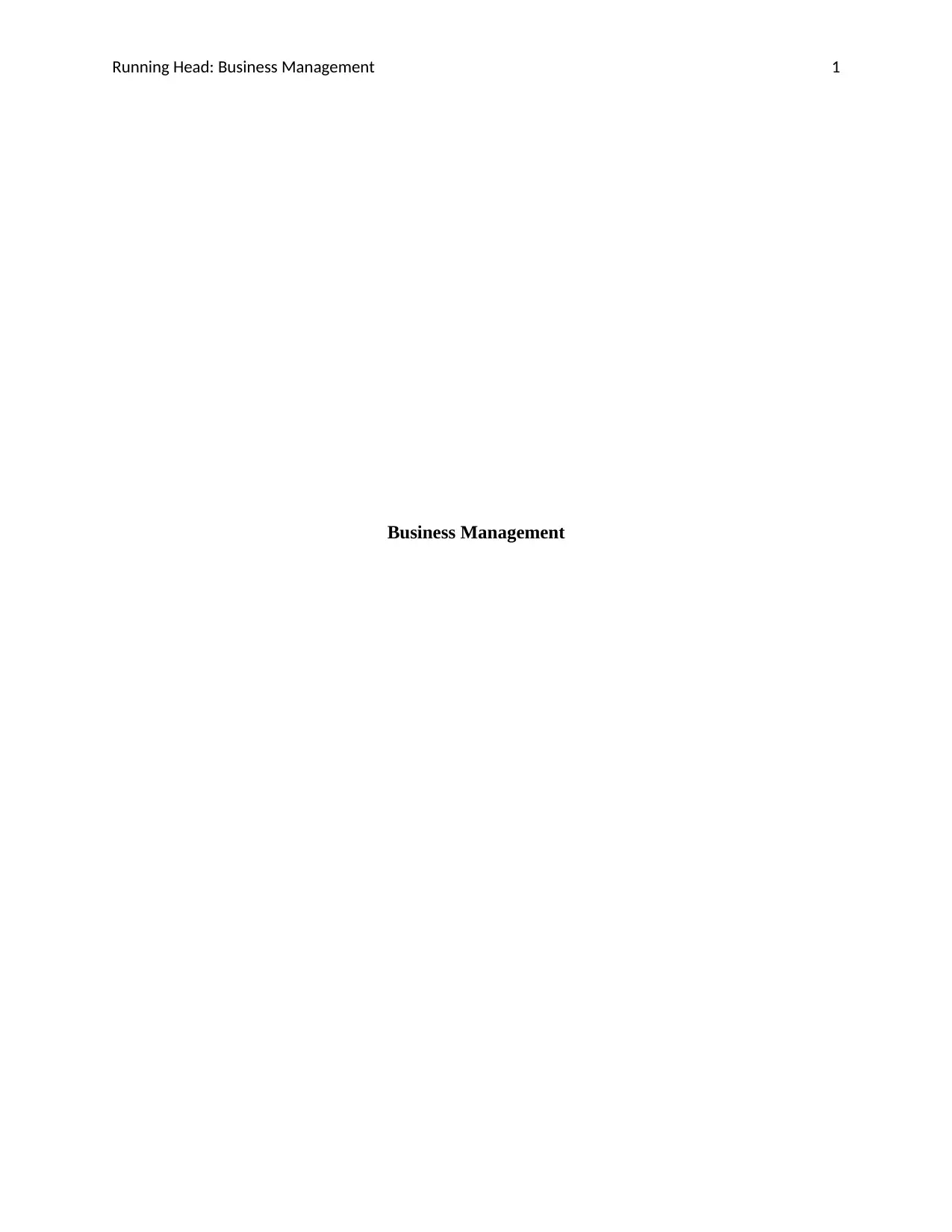
Running Head: Business Management 1
Business Management
Business Management
Paraphrase This Document
Need a fresh take? Get an instant paraphrase of this document with our AI Paraphraser
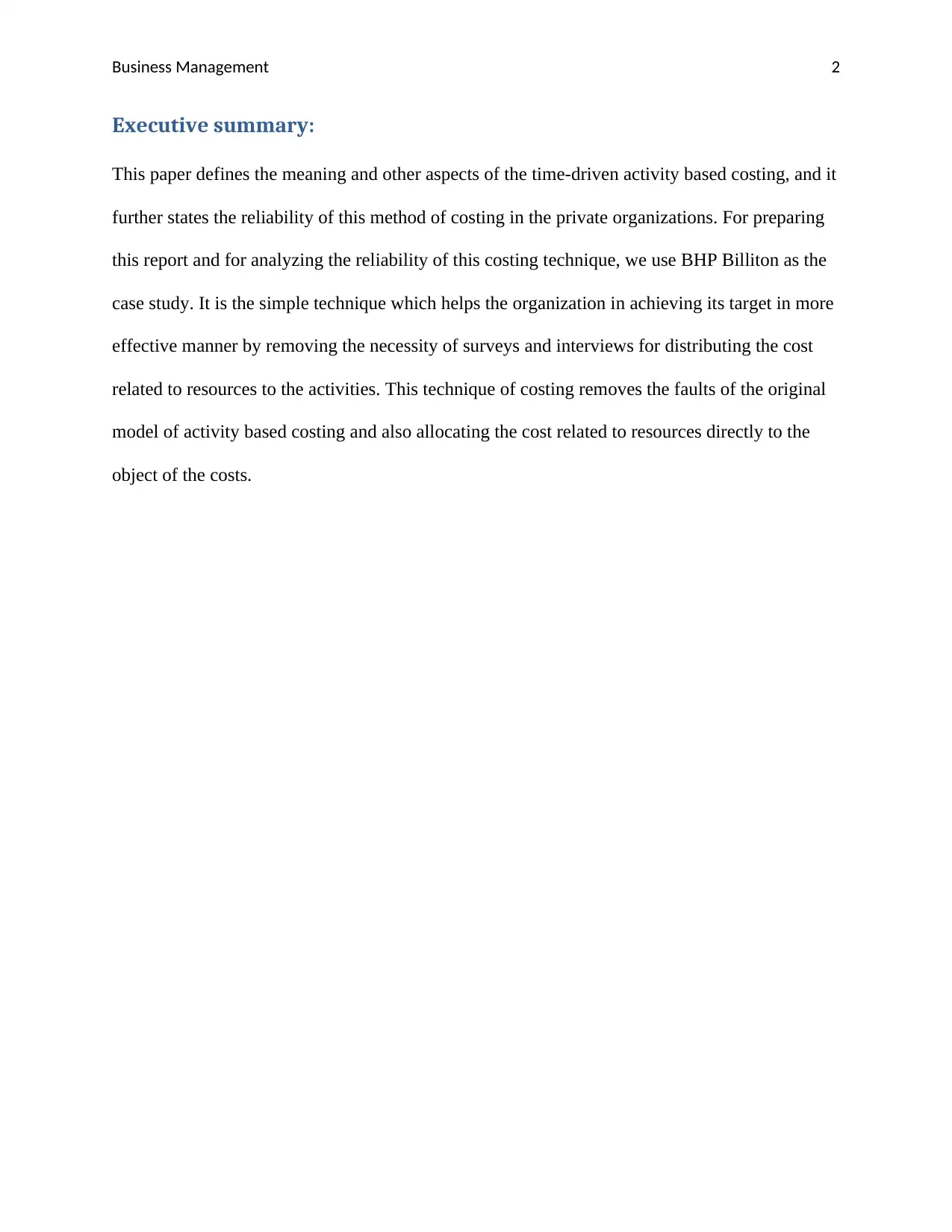
Business Management 2
Executive summary:
This paper defines the meaning and other aspects of the time-driven activity based costing, and it
further states the reliability of this method of costing in the private organizations. For preparing
this report and for analyzing the reliability of this costing technique, we use BHP Billiton as the
case study. It is the simple technique which helps the organization in achieving its target in more
effective manner by removing the necessity of surveys and interviews for distributing the cost
related to resources to the activities. This technique of costing removes the faults of the original
model of activity based costing and also allocating the cost related to resources directly to the
object of the costs.
Executive summary:
This paper defines the meaning and other aspects of the time-driven activity based costing, and it
further states the reliability of this method of costing in the private organizations. For preparing
this report and for analyzing the reliability of this costing technique, we use BHP Billiton as the
case study. It is the simple technique which helps the organization in achieving its target in more
effective manner by removing the necessity of surveys and interviews for distributing the cost
related to resources to the activities. This technique of costing removes the faults of the original
model of activity based costing and also allocating the cost related to resources directly to the
object of the costs.
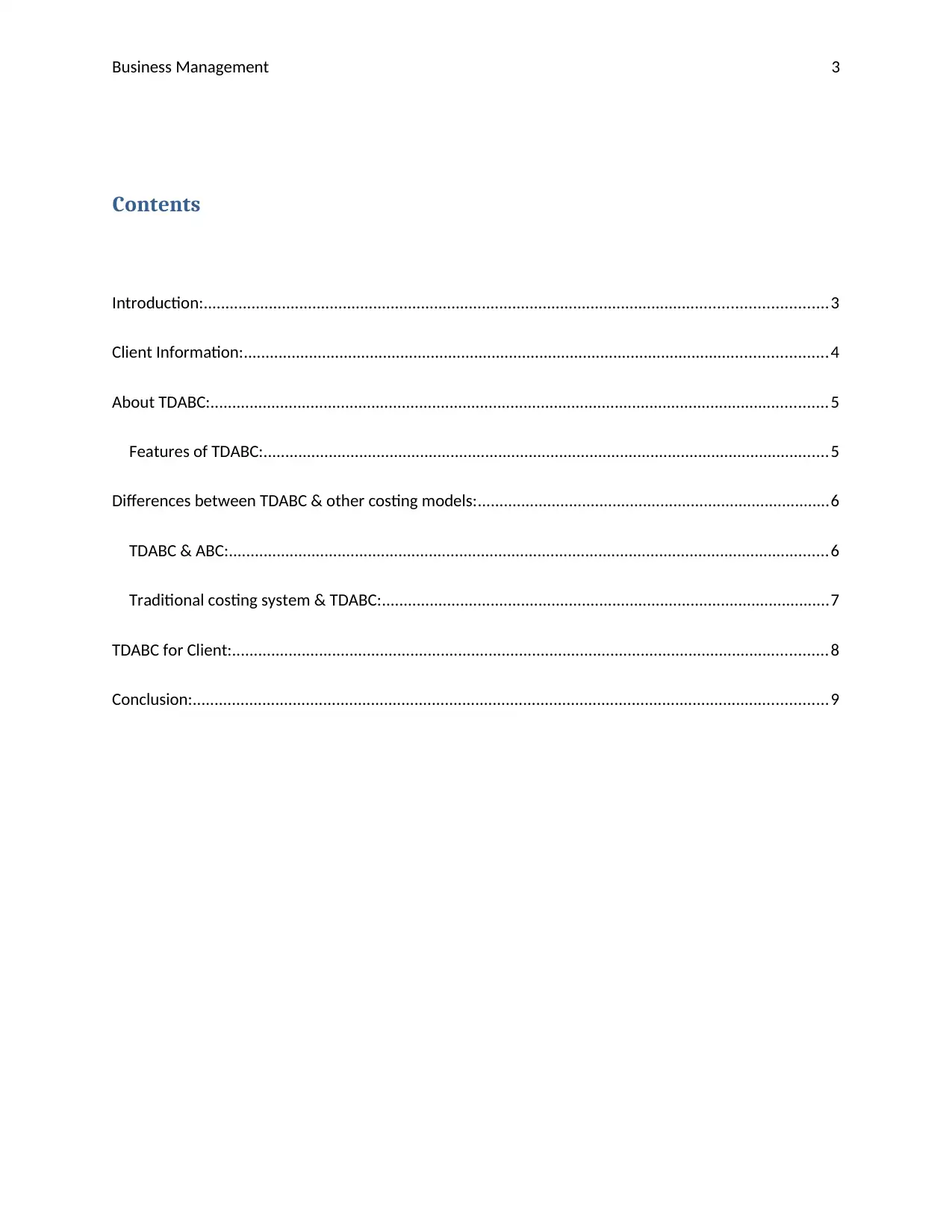
Business Management 3
Contents
Introduction:...............................................................................................................................................3
Client Information:......................................................................................................................................4
About TDABC:..............................................................................................................................................5
Features of TDABC:..................................................................................................................................5
Differences between TDABC & other costing models:.................................................................................6
TDABC & ABC:..........................................................................................................................................6
Traditional costing system & TDABC:.......................................................................................................7
TDABC for Client:.........................................................................................................................................8
Conclusion:..................................................................................................................................................9
Contents
Introduction:...............................................................................................................................................3
Client Information:......................................................................................................................................4
About TDABC:..............................................................................................................................................5
Features of TDABC:..................................................................................................................................5
Differences between TDABC & other costing models:.................................................................................6
TDABC & ABC:..........................................................................................................................................6
Traditional costing system & TDABC:.......................................................................................................7
TDABC for Client:.........................................................................................................................................8
Conclusion:..................................................................................................................................................9
⊘ This is a preview!⊘
Do you want full access?
Subscribe today to unlock all pages.

Trusted by 1+ million students worldwide
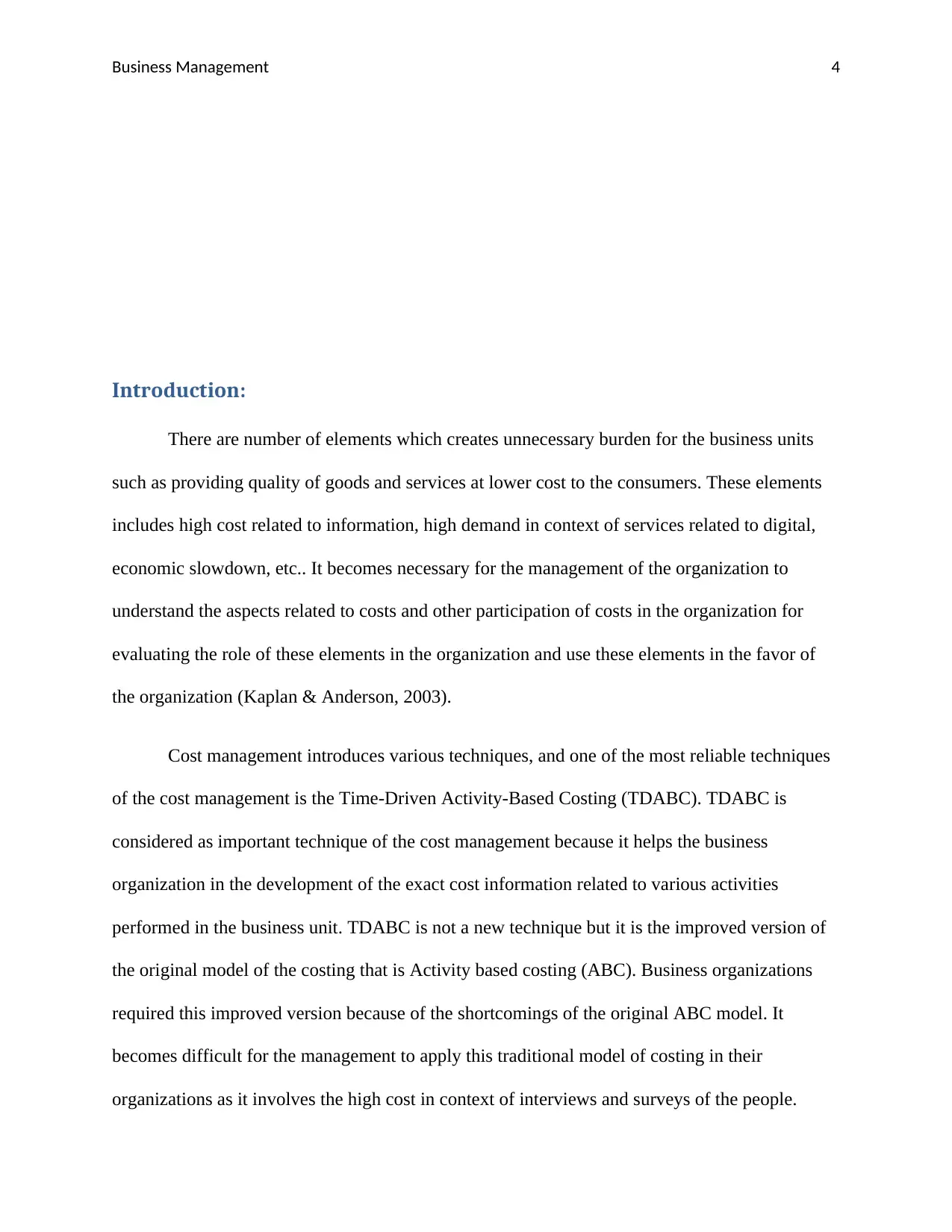
Business Management 4
Introduction:
There are number of elements which creates unnecessary burden for the business units
such as providing quality of goods and services at lower cost to the consumers. These elements
includes high cost related to information, high demand in context of services related to digital,
economic slowdown, etc.. It becomes necessary for the management of the organization to
understand the aspects related to costs and other participation of costs in the organization for
evaluating the role of these elements in the organization and use these elements in the favor of
the organization (Kaplan & Anderson, 2003).
Cost management introduces various techniques, and one of the most reliable techniques
of the cost management is the Time-Driven Activity-Based Costing (TDABC). TDABC is
considered as important technique of the cost management because it helps the business
organization in the development of the exact cost information related to various activities
performed in the business unit. TDABC is not a new technique but it is the improved version of
the original model of the costing that is Activity based costing (ABC). Business organizations
required this improved version because of the shortcomings of the original ABC model. It
becomes difficult for the management to apply this traditional model of costing in their
organizations as it involves the high cost in context of interviews and surveys of the people.
Introduction:
There are number of elements which creates unnecessary burden for the business units
such as providing quality of goods and services at lower cost to the consumers. These elements
includes high cost related to information, high demand in context of services related to digital,
economic slowdown, etc.. It becomes necessary for the management of the organization to
understand the aspects related to costs and other participation of costs in the organization for
evaluating the role of these elements in the organization and use these elements in the favor of
the organization (Kaplan & Anderson, 2003).
Cost management introduces various techniques, and one of the most reliable techniques
of the cost management is the Time-Driven Activity-Based Costing (TDABC). TDABC is
considered as important technique of the cost management because it helps the business
organization in the development of the exact cost information related to various activities
performed in the business unit. TDABC is not a new technique but it is the improved version of
the original model of the costing that is Activity based costing (ABC). Business organizations
required this improved version because of the shortcomings of the original ABC model. It
becomes difficult for the management to apply this traditional model of costing in their
organizations as it involves the high cost in context of interviews and surveys of the people.
Paraphrase This Document
Need a fresh take? Get an instant paraphrase of this document with our AI Paraphraser
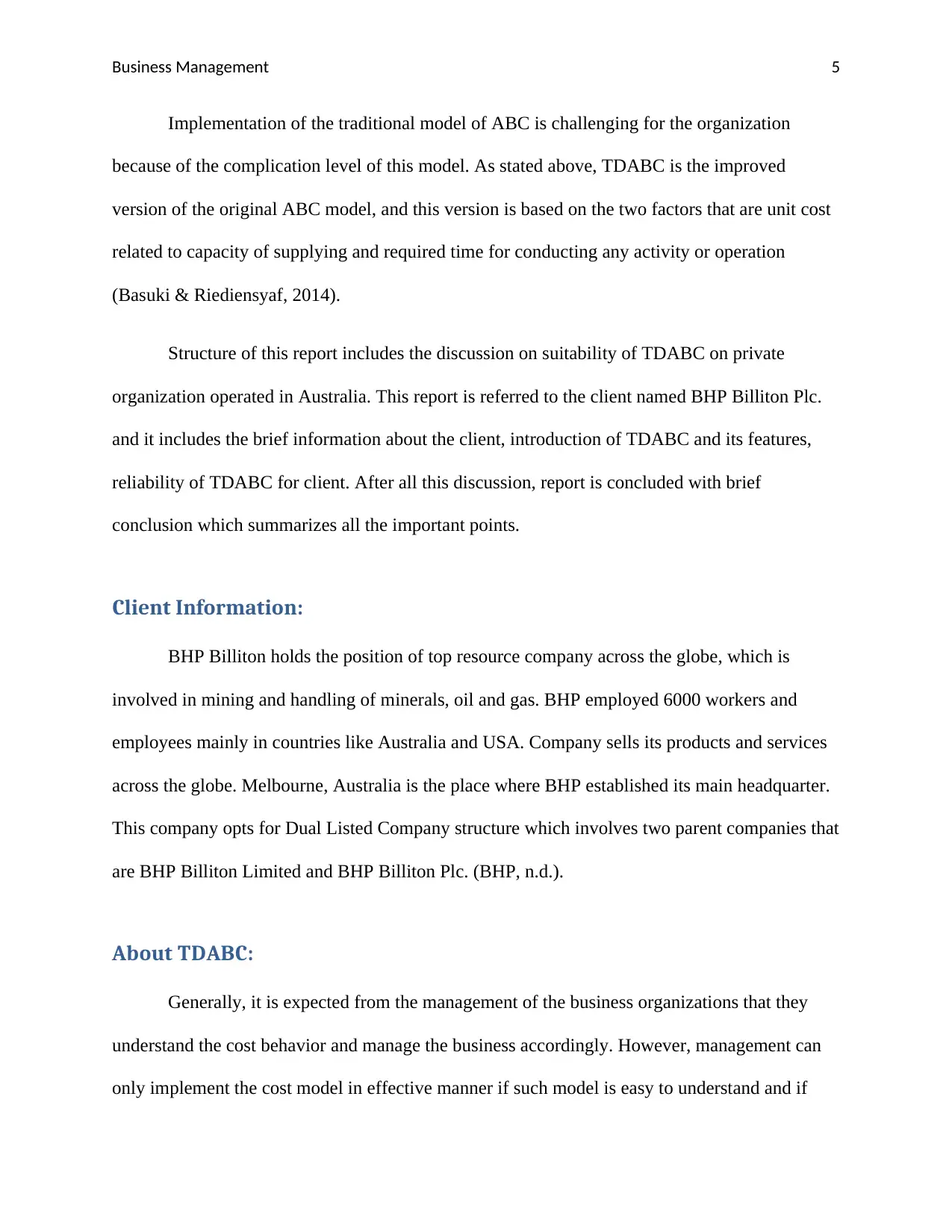
Business Management 5
Implementation of the traditional model of ABC is challenging for the organization
because of the complication level of this model. As stated above, TDABC is the improved
version of the original ABC model, and this version is based on the two factors that are unit cost
related to capacity of supplying and required time for conducting any activity or operation
(Basuki & Riediensyaf, 2014).
Structure of this report includes the discussion on suitability of TDABC on private
organization operated in Australia. This report is referred to the client named BHP Billiton Plc.
and it includes the brief information about the client, introduction of TDABC and its features,
reliability of TDABC for client. After all this discussion, report is concluded with brief
conclusion which summarizes all the important points.
Client Information:
BHP Billiton holds the position of top resource company across the globe, which is
involved in mining and handling of minerals, oil and gas. BHP employed 6000 workers and
employees mainly in countries like Australia and USA. Company sells its products and services
across the globe. Melbourne, Australia is the place where BHP established its main headquarter.
This company opts for Dual Listed Company structure which involves two parent companies that
are BHP Billiton Limited and BHP Billiton Plc. (BHP, n.d.).
About TDABC:
Generally, it is expected from the management of the business organizations that they
understand the cost behavior and manage the business accordingly. However, management can
only implement the cost model in effective manner if such model is easy to understand and if
Implementation of the traditional model of ABC is challenging for the organization
because of the complication level of this model. As stated above, TDABC is the improved
version of the original ABC model, and this version is based on the two factors that are unit cost
related to capacity of supplying and required time for conducting any activity or operation
(Basuki & Riediensyaf, 2014).
Structure of this report includes the discussion on suitability of TDABC on private
organization operated in Australia. This report is referred to the client named BHP Billiton Plc.
and it includes the brief information about the client, introduction of TDABC and its features,
reliability of TDABC for client. After all this discussion, report is concluded with brief
conclusion which summarizes all the important points.
Client Information:
BHP Billiton holds the position of top resource company across the globe, which is
involved in mining and handling of minerals, oil and gas. BHP employed 6000 workers and
employees mainly in countries like Australia and USA. Company sells its products and services
across the globe. Melbourne, Australia is the place where BHP established its main headquarter.
This company opts for Dual Listed Company structure which involves two parent companies that
are BHP Billiton Limited and BHP Billiton Plc. (BHP, n.d.).
About TDABC:
Generally, it is expected from the management of the business organizations that they
understand the cost behavior and manage the business accordingly. However, management can
only implement the cost model in effective manner if such model is easy to understand and if
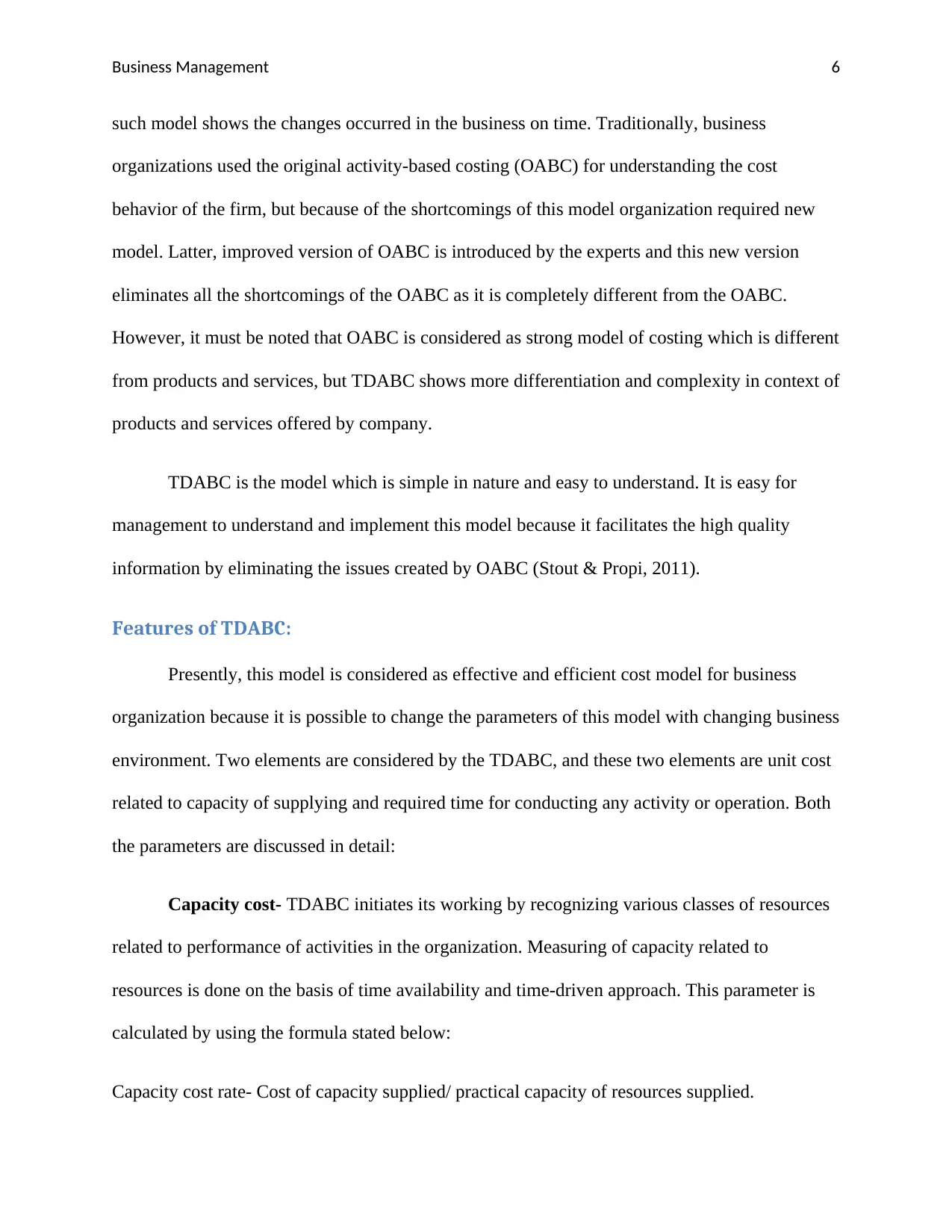
Business Management 6
such model shows the changes occurred in the business on time. Traditionally, business
organizations used the original activity-based costing (OABC) for understanding the cost
behavior of the firm, but because of the shortcomings of this model organization required new
model. Latter, improved version of OABC is introduced by the experts and this new version
eliminates all the shortcomings of the OABC as it is completely different from the OABC.
However, it must be noted that OABC is considered as strong model of costing which is different
from products and services, but TDABC shows more differentiation and complexity in context of
products and services offered by company.
TDABC is the model which is simple in nature and easy to understand. It is easy for
management to understand and implement this model because it facilitates the high quality
information by eliminating the issues created by OABC (Stout & Propi, 2011).
Features of TDABC:
Presently, this model is considered as effective and efficient cost model for business
organization because it is possible to change the parameters of this model with changing business
environment. Two elements are considered by the TDABC, and these two elements are unit cost
related to capacity of supplying and required time for conducting any activity or operation. Both
the parameters are discussed in detail:
Capacity cost- TDABC initiates its working by recognizing various classes of resources
related to performance of activities in the organization. Measuring of capacity related to
resources is done on the basis of time availability and time-driven approach. This parameter is
calculated by using the formula stated below:
Capacity cost rate- Cost of capacity supplied/ practical capacity of resources supplied.
such model shows the changes occurred in the business on time. Traditionally, business
organizations used the original activity-based costing (OABC) for understanding the cost
behavior of the firm, but because of the shortcomings of this model organization required new
model. Latter, improved version of OABC is introduced by the experts and this new version
eliminates all the shortcomings of the OABC as it is completely different from the OABC.
However, it must be noted that OABC is considered as strong model of costing which is different
from products and services, but TDABC shows more differentiation and complexity in context of
products and services offered by company.
TDABC is the model which is simple in nature and easy to understand. It is easy for
management to understand and implement this model because it facilitates the high quality
information by eliminating the issues created by OABC (Stout & Propi, 2011).
Features of TDABC:
Presently, this model is considered as effective and efficient cost model for business
organization because it is possible to change the parameters of this model with changing business
environment. Two elements are considered by the TDABC, and these two elements are unit cost
related to capacity of supplying and required time for conducting any activity or operation. Both
the parameters are discussed in detail:
Capacity cost- TDABC initiates its working by recognizing various classes of resources
related to performance of activities in the organization. Measuring of capacity related to
resources is done on the basis of time availability and time-driven approach. This parameter is
calculated by using the formula stated below:
Capacity cost rate- Cost of capacity supplied/ practical capacity of resources supplied.
⊘ This is a preview!⊘
Do you want full access?
Subscribe today to unlock all pages.

Trusted by 1+ million students worldwide
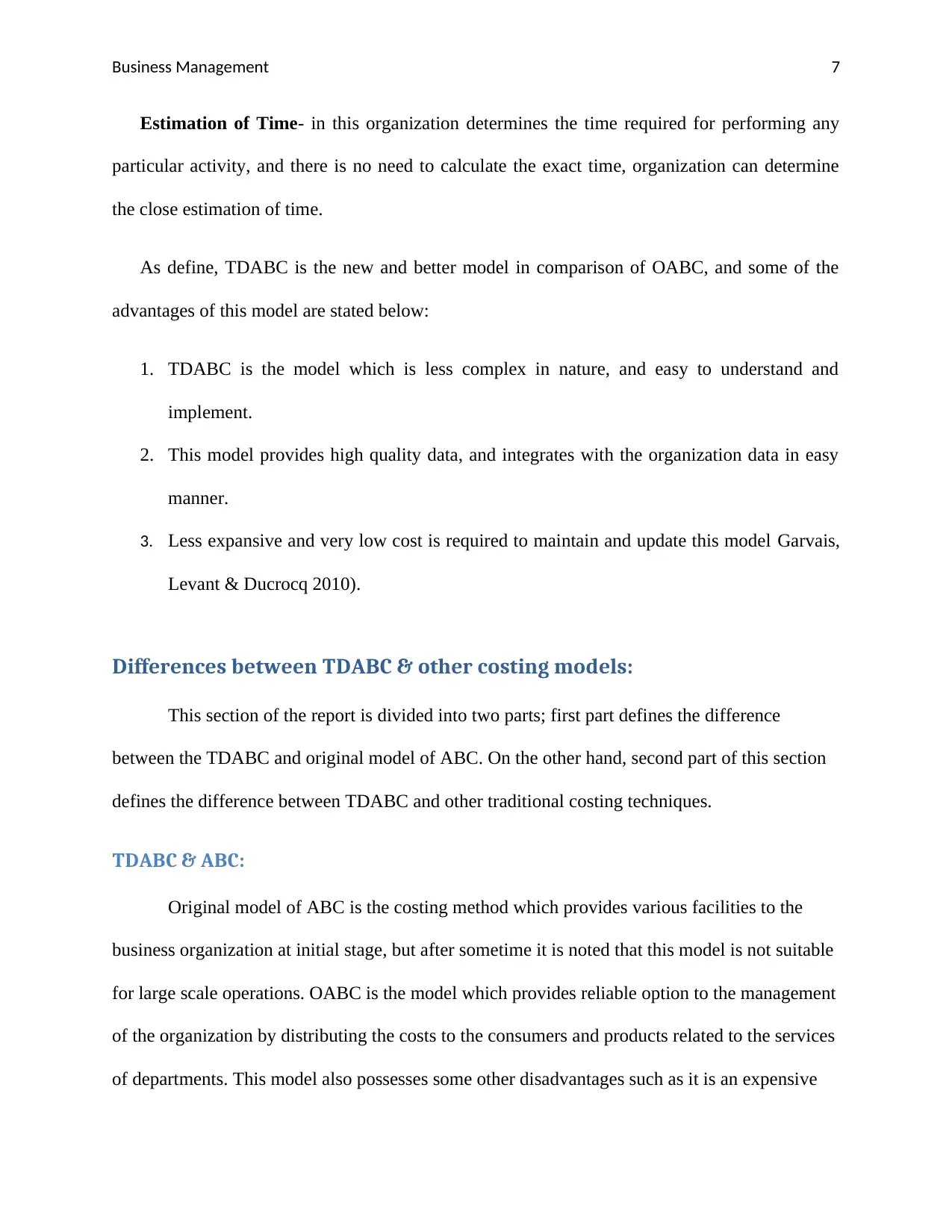
Business Management 7
Estimation of Time- in this organization determines the time required for performing any
particular activity, and there is no need to calculate the exact time, organization can determine
the close estimation of time.
As define, TDABC is the new and better model in comparison of OABC, and some of the
advantages of this model are stated below:
1. TDABC is the model which is less complex in nature, and easy to understand and
implement.
2. This model provides high quality data, and integrates with the organization data in easy
manner.
3. Less expansive and very low cost is required to maintain and update this model Garvais,
Levant & Ducrocq 2010).
Differences between TDABC & other costing models:
This section of the report is divided into two parts; first part defines the difference
between the TDABC and original model of ABC. On the other hand, second part of this section
defines the difference between TDABC and other traditional costing techniques.
TDABC & ABC:
Original model of ABC is the costing method which provides various facilities to the
business organization at initial stage, but after sometime it is noted that this model is not suitable
for large scale operations. OABC is the model which provides reliable option to the management
of the organization by distributing the costs to the consumers and products related to the services
of departments. This model also possesses some other disadvantages such as it is an expensive
Estimation of Time- in this organization determines the time required for performing any
particular activity, and there is no need to calculate the exact time, organization can determine
the close estimation of time.
As define, TDABC is the new and better model in comparison of OABC, and some of the
advantages of this model are stated below:
1. TDABC is the model which is less complex in nature, and easy to understand and
implement.
2. This model provides high quality data, and integrates with the organization data in easy
manner.
3. Less expansive and very low cost is required to maintain and update this model Garvais,
Levant & Ducrocq 2010).
Differences between TDABC & other costing models:
This section of the report is divided into two parts; first part defines the difference
between the TDABC and original model of ABC. On the other hand, second part of this section
defines the difference between TDABC and other traditional costing techniques.
TDABC & ABC:
Original model of ABC is the costing method which provides various facilities to the
business organization at initial stage, but after sometime it is noted that this model is not suitable
for large scale operations. OABC is the model which provides reliable option to the management
of the organization by distributing the costs to the consumers and products related to the services
of departments. This model also possesses some other disadvantages such as it is an expensive
Paraphrase This Document
Need a fresh take? Get an instant paraphrase of this document with our AI Paraphraser

Business Management 8
model and complex in nature. Elimination of OABC is not an option for the organizations
because concept of this model is useful and strong, and it provides huge potential for companies
in context of large scale operations. Later, simple approach of this model is developed by the
experts and this approach is known as the time-driven ABC. Difference between the OABC and
TDABC is stated below:
TDABC ABC
It is easy to maintain and update this system,
because maintaining and installation of this
model is not costly.
OABC model is an expensive model which
involves high maintenance cost.
Management applied and understands this
model easily.
This model is complex in nature.
Duration cost drivers is the parameter which is
used by the TDABC.
Transaction cost drivers is the method which is
used by OABC (Hayden, n.d.).
Traditional costing system & TDABC:
Traditional costing techniques used the application of indirect cost on products and this
cost is based on the preset overhead rate. In this overhead cost is considered on the basis of
single group which directly relates with indirect cost. It is suitable in the organizations where
indirect cost is low in comparison of direct costs. Various parameters are used by these methods
such as identification of indirect cost, estimation of that cost for specific time, selection of cost
driver, estimation of cost driver amount, etc. (Accounting Tools, 2015).
model and complex in nature. Elimination of OABC is not an option for the organizations
because concept of this model is useful and strong, and it provides huge potential for companies
in context of large scale operations. Later, simple approach of this model is developed by the
experts and this approach is known as the time-driven ABC. Difference between the OABC and
TDABC is stated below:
TDABC ABC
It is easy to maintain and update this system,
because maintaining and installation of this
model is not costly.
OABC model is an expensive model which
involves high maintenance cost.
Management applied and understands this
model easily.
This model is complex in nature.
Duration cost drivers is the parameter which is
used by the TDABC.
Transaction cost drivers is the method which is
used by OABC (Hayden, n.d.).
Traditional costing system & TDABC:
Traditional costing techniques used the application of indirect cost on products and this
cost is based on the preset overhead rate. In this overhead cost is considered on the basis of
single group which directly relates with indirect cost. It is suitable in the organizations where
indirect cost is low in comparison of direct costs. Various parameters are used by these methods
such as identification of indirect cost, estimation of that cost for specific time, selection of cost
driver, estimation of cost driver amount, etc. (Accounting Tools, 2015).
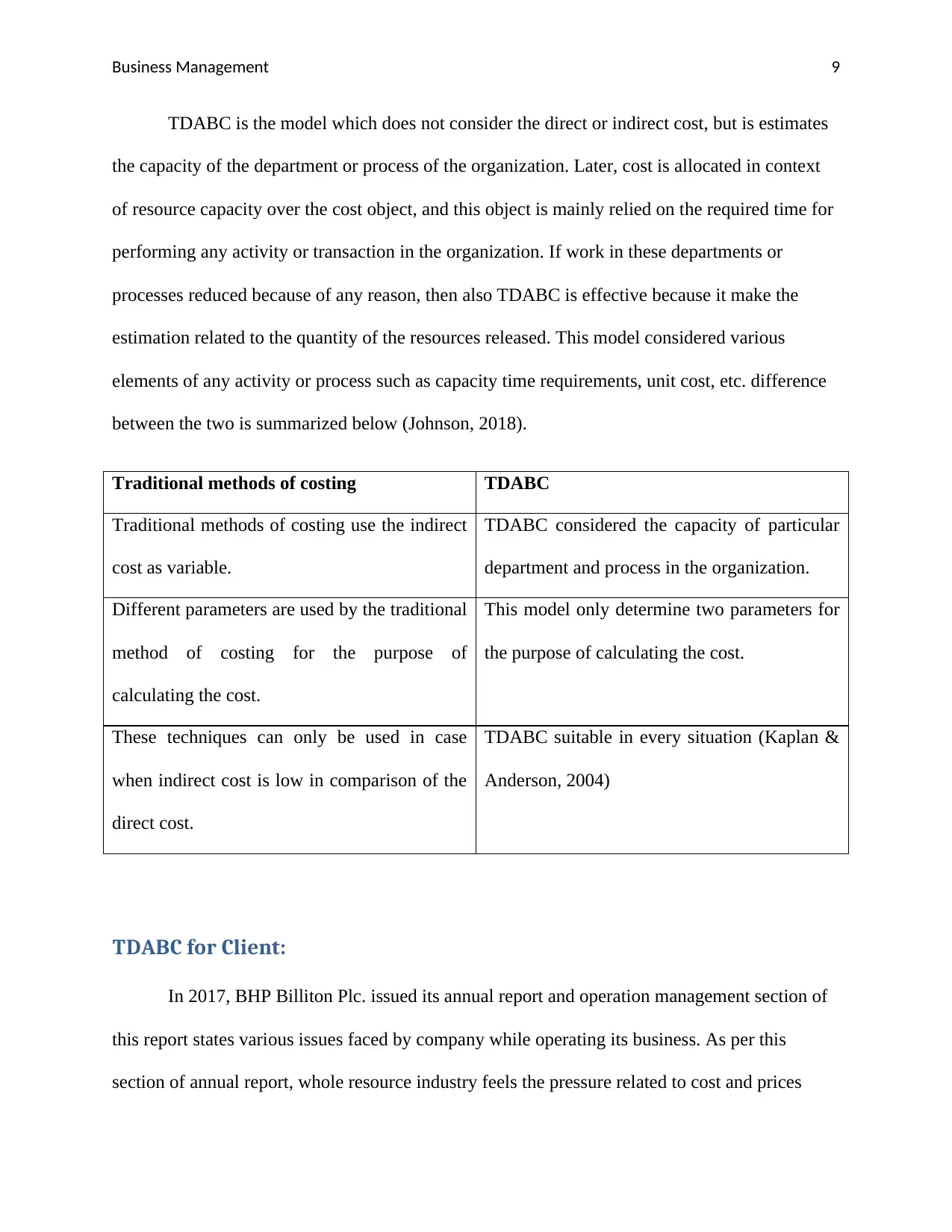
Business Management 9
TDABC is the model which does not consider the direct or indirect cost, but is estimates
the capacity of the department or process of the organization. Later, cost is allocated in context
of resource capacity over the cost object, and this object is mainly relied on the required time for
performing any activity or transaction in the organization. If work in these departments or
processes reduced because of any reason, then also TDABC is effective because it make the
estimation related to the quantity of the resources released. This model considered various
elements of any activity or process such as capacity time requirements, unit cost, etc. difference
between the two is summarized below (Johnson, 2018).
Traditional methods of costing TDABC
Traditional methods of costing use the indirect
cost as variable.
TDABC considered the capacity of particular
department and process in the organization.
Different parameters are used by the traditional
method of costing for the purpose of
calculating the cost.
This model only determine two parameters for
the purpose of calculating the cost.
These techniques can only be used in case
when indirect cost is low in comparison of the
direct cost.
TDABC suitable in every situation (Kaplan &
Anderson, 2004)
TDABC for Client:
In 2017, BHP Billiton Plc. issued its annual report and operation management section of
this report states various issues faced by company while operating its business. As per this
section of annual report, whole resource industry feels the pressure related to cost and prices
TDABC is the model which does not consider the direct or indirect cost, but is estimates
the capacity of the department or process of the organization. Later, cost is allocated in context
of resource capacity over the cost object, and this object is mainly relied on the required time for
performing any activity or transaction in the organization. If work in these departments or
processes reduced because of any reason, then also TDABC is effective because it make the
estimation related to the quantity of the resources released. This model considered various
elements of any activity or process such as capacity time requirements, unit cost, etc. difference
between the two is summarized below (Johnson, 2018).
Traditional methods of costing TDABC
Traditional methods of costing use the indirect
cost as variable.
TDABC considered the capacity of particular
department and process in the organization.
Different parameters are used by the traditional
method of costing for the purpose of
calculating the cost.
This model only determine two parameters for
the purpose of calculating the cost.
These techniques can only be used in case
when indirect cost is low in comparison of the
direct cost.
TDABC suitable in every situation (Kaplan &
Anderson, 2004)
TDABC for Client:
In 2017, BHP Billiton Plc. issued its annual report and operation management section of
this report states various issues faced by company while operating its business. As per this
section of annual report, whole resource industry feels the pressure related to cost and prices
⊘ This is a preview!⊘
Do you want full access?
Subscribe today to unlock all pages.

Trusted by 1+ million students worldwide
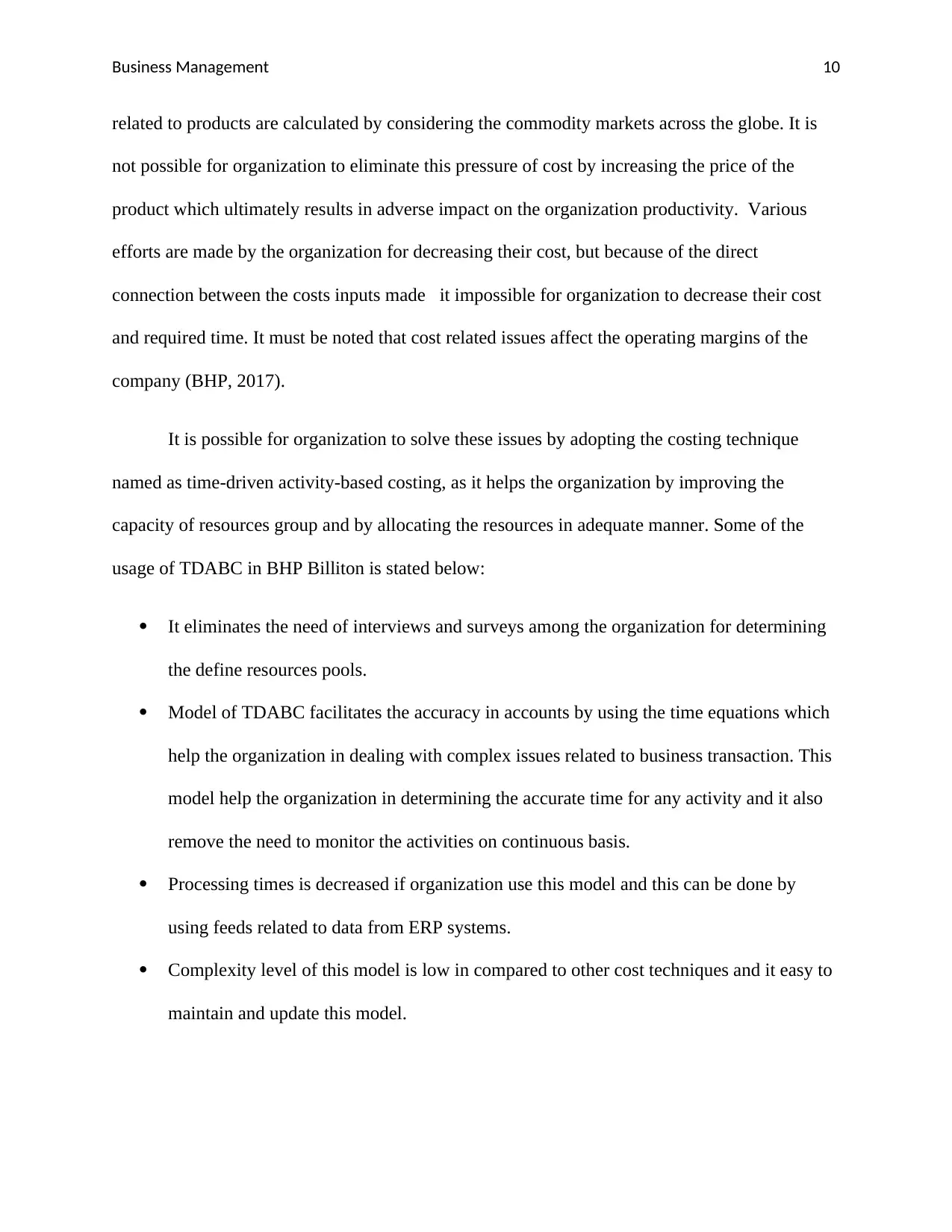
Business Management 10
related to products are calculated by considering the commodity markets across the globe. It is
not possible for organization to eliminate this pressure of cost by increasing the price of the
product which ultimately results in adverse impact on the organization productivity. Various
efforts are made by the organization for decreasing their cost, but because of the direct
connection between the costs inputs made it impossible for organization to decrease their cost
and required time. It must be noted that cost related issues affect the operating margins of the
company (BHP, 2017).
It is possible for organization to solve these issues by adopting the costing technique
named as time-driven activity-based costing, as it helps the organization by improving the
capacity of resources group and by allocating the resources in adequate manner. Some of the
usage of TDABC in BHP Billiton is stated below:
It eliminates the need of interviews and surveys among the organization for determining
the define resources pools.
Model of TDABC facilitates the accuracy in accounts by using the time equations which
help the organization in dealing with complex issues related to business transaction. This
model help the organization in determining the accurate time for any activity and it also
remove the need to monitor the activities on continuous basis.
Processing times is decreased if organization use this model and this can be done by
using feeds related to data from ERP systems.
Complexity level of this model is low in compared to other cost techniques and it easy to
maintain and update this model.
related to products are calculated by considering the commodity markets across the globe. It is
not possible for organization to eliminate this pressure of cost by increasing the price of the
product which ultimately results in adverse impact on the organization productivity. Various
efforts are made by the organization for decreasing their cost, but because of the direct
connection between the costs inputs made it impossible for organization to decrease their cost
and required time. It must be noted that cost related issues affect the operating margins of the
company (BHP, 2017).
It is possible for organization to solve these issues by adopting the costing technique
named as time-driven activity-based costing, as it helps the organization by improving the
capacity of resources group and by allocating the resources in adequate manner. Some of the
usage of TDABC in BHP Billiton is stated below:
It eliminates the need of interviews and surveys among the organization for determining
the define resources pools.
Model of TDABC facilitates the accuracy in accounts by using the time equations which
help the organization in dealing with complex issues related to business transaction. This
model help the organization in determining the accurate time for any activity and it also
remove the need to monitor the activities on continuous basis.
Processing times is decreased if organization use this model and this can be done by
using feeds related to data from ERP systems.
Complexity level of this model is low in compared to other cost techniques and it easy to
maintain and update this model.
Paraphrase This Document
Need a fresh take? Get an instant paraphrase of this document with our AI Paraphraser
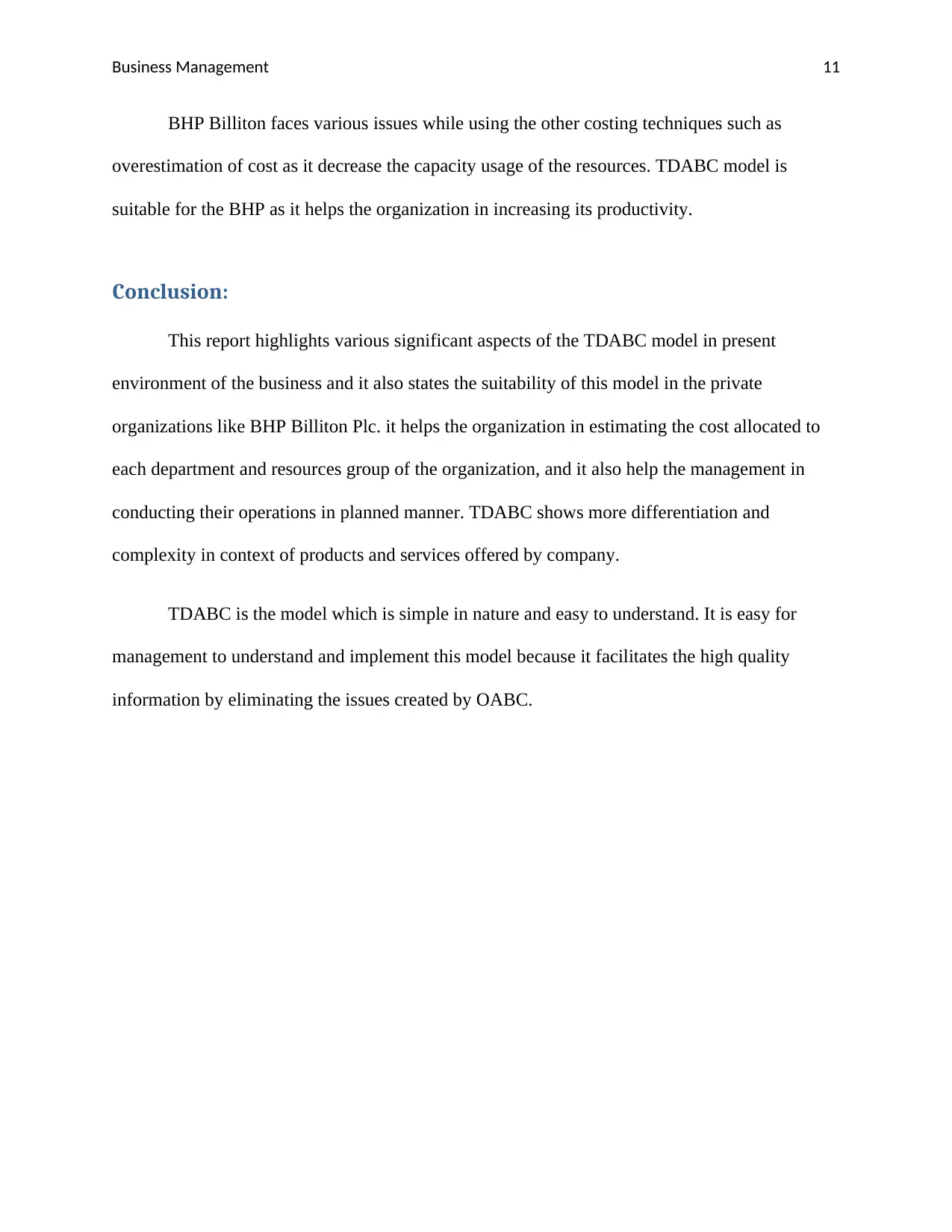
Business Management 11
BHP Billiton faces various issues while using the other costing techniques such as
overestimation of cost as it decrease the capacity usage of the resources. TDABC model is
suitable for the BHP as it helps the organization in increasing its productivity.
Conclusion:
This report highlights various significant aspects of the TDABC model in present
environment of the business and it also states the suitability of this model in the private
organizations like BHP Billiton Plc. it helps the organization in estimating the cost allocated to
each department and resources group of the organization, and it also help the management in
conducting their operations in planned manner. TDABC shows more differentiation and
complexity in context of products and services offered by company.
TDABC is the model which is simple in nature and easy to understand. It is easy for
management to understand and implement this model because it facilitates the high quality
information by eliminating the issues created by OABC.
BHP Billiton faces various issues while using the other costing techniques such as
overestimation of cost as it decrease the capacity usage of the resources. TDABC model is
suitable for the BHP as it helps the organization in increasing its productivity.
Conclusion:
This report highlights various significant aspects of the TDABC model in present
environment of the business and it also states the suitability of this model in the private
organizations like BHP Billiton Plc. it helps the organization in estimating the cost allocated to
each department and resources group of the organization, and it also help the management in
conducting their operations in planned manner. TDABC shows more differentiation and
complexity in context of products and services offered by company.
TDABC is the model which is simple in nature and easy to understand. It is easy for
management to understand and implement this model because it facilitates the high quality
information by eliminating the issues created by OABC.
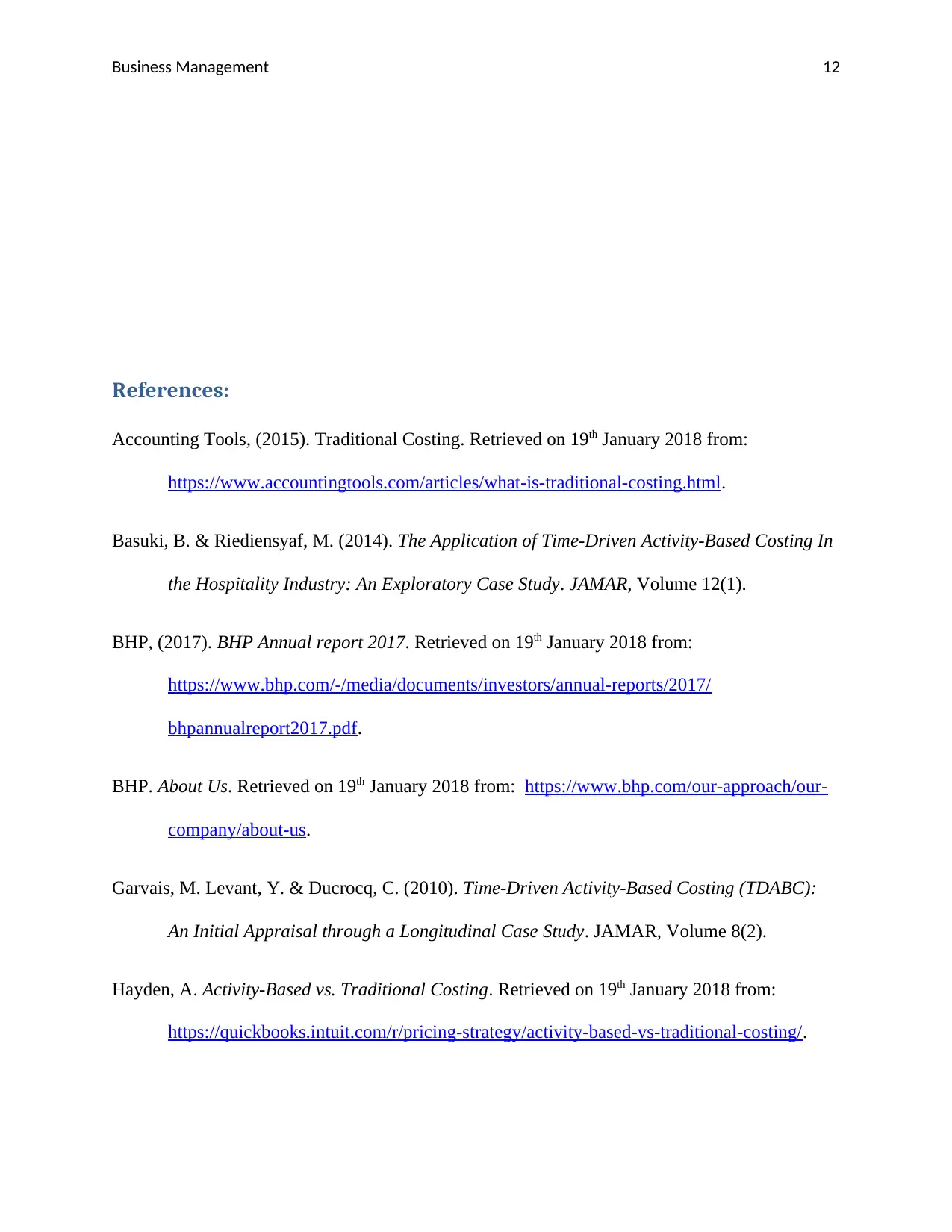
Business Management 12
References:
Accounting Tools, (2015). Traditional Costing. Retrieved on 19th January 2018 from:
https://www.accountingtools.com/articles/what-is-traditional-costing.html.
Basuki, B. & Riediensyaf, M. (2014). The Application of Time-Driven Activity-Based Costing In
the Hospitality Industry: An Exploratory Case Study. JAMAR, Volume 12(1).
BHP, (2017). BHP Annual report 2017. Retrieved on 19th January 2018 from:
https://www.bhp.com/-/media/documents/investors/annual-reports/2017/
bhpannualreport2017.pdf.
BHP. About Us. Retrieved on 19th January 2018 from: https://www.bhp.com/our-approach/our-
company/about-us.
Garvais, M. Levant, Y. & Ducrocq, C. (2010). Time-Driven Activity-Based Costing (TDABC):
An Initial Appraisal through a Longitudinal Case Study. JAMAR, Volume 8(2).
Hayden, A. Activity-Based vs. Traditional Costing. Retrieved on 19th January 2018 from:
https://quickbooks.intuit.com/r/pricing-strategy/activity-based-vs-traditional-costing/.
References:
Accounting Tools, (2015). Traditional Costing. Retrieved on 19th January 2018 from:
https://www.accountingtools.com/articles/what-is-traditional-costing.html.
Basuki, B. & Riediensyaf, M. (2014). The Application of Time-Driven Activity-Based Costing In
the Hospitality Industry: An Exploratory Case Study. JAMAR, Volume 12(1).
BHP, (2017). BHP Annual report 2017. Retrieved on 19th January 2018 from:
https://www.bhp.com/-/media/documents/investors/annual-reports/2017/
bhpannualreport2017.pdf.
BHP. About Us. Retrieved on 19th January 2018 from: https://www.bhp.com/our-approach/our-
company/about-us.
Garvais, M. Levant, Y. & Ducrocq, C. (2010). Time-Driven Activity-Based Costing (TDABC):
An Initial Appraisal through a Longitudinal Case Study. JAMAR, Volume 8(2).
Hayden, A. Activity-Based vs. Traditional Costing. Retrieved on 19th January 2018 from:
https://quickbooks.intuit.com/r/pricing-strategy/activity-based-vs-traditional-costing/.
⊘ This is a preview!⊘
Do you want full access?
Subscribe today to unlock all pages.

Trusted by 1+ million students worldwide
1 out of 13
Related Documents
Your All-in-One AI-Powered Toolkit for Academic Success.
+13062052269
info@desklib.com
Available 24*7 on WhatsApp / Email
![[object Object]](/_next/static/media/star-bottom.7253800d.svg)
Unlock your academic potential
Copyright © 2020–2025 A2Z Services. All Rights Reserved. Developed and managed by ZUCOL.





